wheel alignment CHEVROLET HHR 2007 1.G Owners Manual
[x] Cancel search | Manufacturer: CHEVROLET, Model Year: 2007, Model line: HHR, Model: CHEVROLET HHR 2007 1.GPages: 446, PDF Size: 2.43 MB
Page 288 of 446
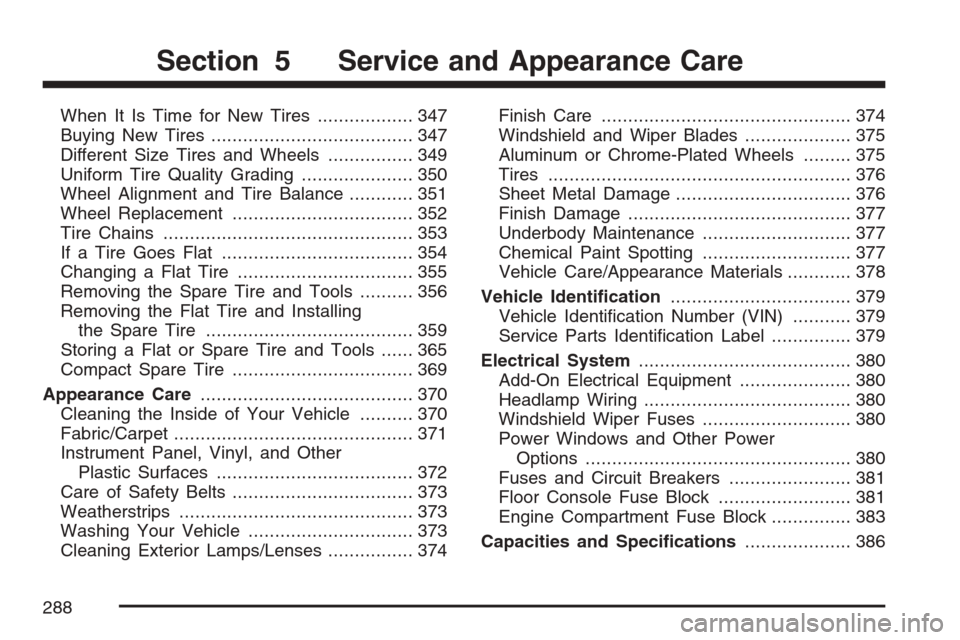
When It Is Time for New Tires.................. 347
Buying New Tires...................................... 347
Different Size Tires and Wheels................ 349
Uniform Tire Quality Grading..................... 350
Wheel Alignment and Tire Balance............ 351
Wheel Replacement.................................. 352
Tire Chains............................................... 353
If a Tire Goes Flat.................................... 354
Changing a Flat Tire................................. 355
Removing the Spare Tire and Tools.......... 356
Removing the Flat Tire and Installing
the Spare Tire....................................... 359
Storing a Flat or Spare Tire and Tools...... 365
Compact Spare Tire.................................. 369
Appearance Care........................................ 370
Cleaning the Inside of Your Vehicle.......... 370
Fabric/Carpet............................................. 371
Instrument Panel, Vinyl, and Other
Plastic Surfaces..................................... 372
Care of Safety Belts.................................. 373
Weatherstrips............................................ 373
Washing Your Vehicle............................... 373
Cleaning Exterior Lamps/Lenses................ 374Finish Care............................................... 374
Windshield and Wiper Blades.................... 375
Aluminum or Chrome-Plated Wheels......... 375
Tires......................................................... 376
Sheet Metal Damage................................. 376
Finish Damage.......................................... 377
Underbody Maintenance............................ 377
Chemical Paint Spotting............................ 377
Vehicle Care/Appearance Materials............ 378
Vehicle Identi�cation.................................. 379
Vehicle Identi�cation Number (VIN)........... 379
Service Parts Identi�cation Label............... 379
Electrical System........................................ 380
Add-On Electrical Equipment..................... 380
Headlamp Wiring....................................... 380
Windshield Wiper Fuses............................ 380
Power Windows and Other Power
Options.................................................. 380
Fuses and Circuit Breakers....................... 381
Floor Console Fuse Block......................... 381
Engine Compartment Fuse Block............... 383
Capacities and Speci�cations.................... 386
Section 5 Service and Appearance Care
288
Page 345 of 446
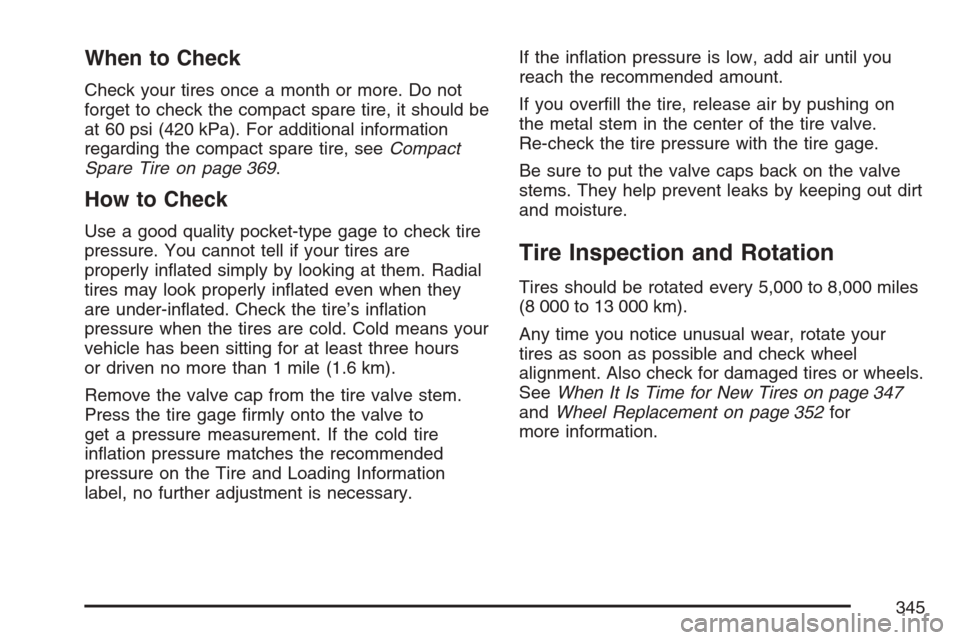
When to Check
Check your tires once a month or more. Do not
forget to check the compact spare tire, it should be
at 60 psi (420 kPa). For additional information
regarding the compact spare tire, seeCompact
Spare Tire on page 369.
How to Check
Use a good quality pocket-type gage to check tire
pressure. You cannot tell if your tires are
properly in�ated simply by looking at them. Radial
tires may look properly in�ated even when they
are under-in�ated. Check the tire’s in�ation
pressure when the tires are cold. Cold means your
vehicle has been sitting for at least three hours
or driven no more than 1 mile (1.6 km).
Remove the valve cap from the tire valve stem.
Press the tire gage �rmly onto the valve to
get a pressure measurement. If the cold tire
in�ation pressure matches the recommended
pressure on the Tire and Loading Information
label, no further adjustment is necessary.If the in�ation pressure is low, add air until you
reach the recommended amount.
If you over�ll the tire, release air by pushing on
the metal stem in the center of the tire valve.
Re-check the tire pressure with the tire gage.
Be sure to put the valve caps back on the valve
stems. They help prevent leaks by keeping out dirt
and moisture.
Tire Inspection and Rotation
Tires should be rotated every 5,000 to 8,000 miles
(8 000 to 13 000 km).
Any time you notice unusual wear, rotate your
tires as soon as possible and check wheel
alignment. Also check for damaged tires or wheels.
SeeWhen It Is Time for New Tires on page 347
andWheel Replacement on page 352for
more information.
345
Page 351 of 446
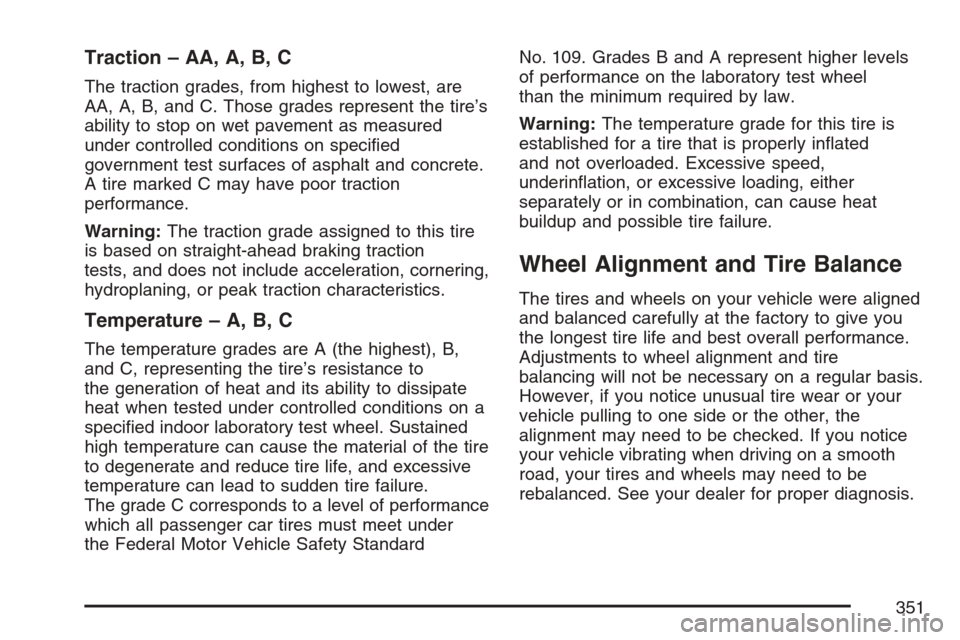
Traction – AA, A, B, C
The traction grades, from highest to lowest, are
AA, A, B, and C. Those grades represent the tire’s
ability to stop on wet pavement as measured
under controlled conditions on speci�ed
government test surfaces of asphalt and concrete.
A tire marked C may have poor traction
performance.
Warning:The traction grade assigned to this tire
is based on straight-ahead braking traction
tests, and does not include acceleration, cornering,
hydroplaning, or peak traction characteristics.
Temperature – A, B, C
The temperature grades are A (the highest), B,
and C, representing the tire’s resistance to
the generation of heat and its ability to dissipate
heat when tested under controlled conditions on a
speci�ed indoor laboratory test wheel. Sustained
high temperature can cause the material of the tire
to degenerate and reduce tire life, and excessive
temperature can lead to sudden tire failure.
The grade C corresponds to a level of performance
which all passenger car tires must meet under
the Federal Motor Vehicle Safety StandardNo. 109. Grades B and A represent higher levels
of performance on the laboratory test wheel
than the minimum required by law.
Warning:The temperature grade for this tire is
established for a tire that is properly in�ated
and not overloaded. Excessive speed,
underin�ation, or excessive loading, either
separately or in combination, can cause heat
buildup and possible tire failure.
Wheel Alignment and Tire Balance
The tires and wheels on your vehicle were aligned
and balanced carefully at the factory to give you
the longest tire life and best overall performance.
Adjustments to wheel alignment and tire
balancing will not be necessary on a regular basis.
However, if you notice unusual tire wear or your
vehicle pulling to one side or the other, the
alignment may need to be checked. If you notice
your vehicle vibrating when driving on a smooth
road, your tires and wheels may need to be
rebalanced. See your dealer for proper diagnosis.
351
Page 445 of 446
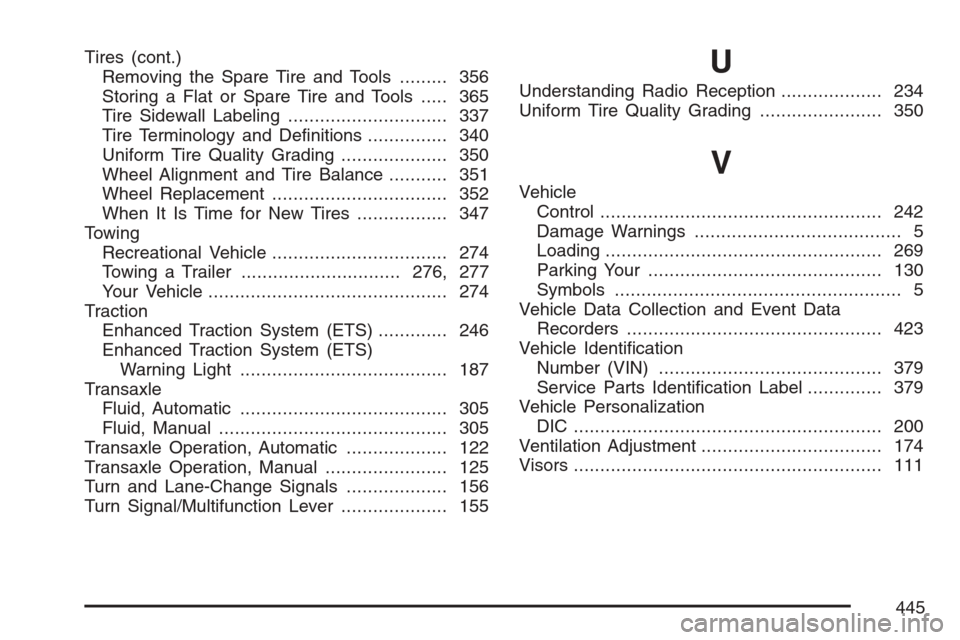
Tires (cont.)
Removing the Spare Tire and Tools......... 356
Storing a Flat or Spare Tire and Tools..... 365
Tire Sidewall Labeling.............................. 337
Tire Terminology and De�nitions............... 340
Uniform Tire Quality Grading.................... 350
Wheel Alignment and Tire Balance........... 351
Wheel Replacement................................. 352
When It Is Time for New Tires................. 347
Towing
Recreational Vehicle................................. 274
Towing a Trailer..............................276, 277
Your Vehicle............................................. 274
Traction
Enhanced Traction System (ETS)............. 246
Enhanced Traction System (ETS)
Warning Light....................................... 187
Transaxle
Fluid, Automatic....................................... 305
Fluid, Manual........................................... 305
Transaxle Operation, Automatic................... 122
Transaxle Operation, Manual....................... 125
Turn and Lane-Change Signals................... 156
Turn Signal/Multifunction Lever.................... 155U
Understanding Radio Reception................... 234
Uniform Tire Quality Grading....................... 350
V
Vehicle
Control..................................................... 242
Damage Warnings....................................... 5
Loading.................................................... 269
Parking Your............................................ 130
Symbols...................................................... 5
Vehicle Data Collection and Event Data
Recorders................................................ 423
Vehicle Identi�cation
Number (VIN).......................................... 379
Service Parts Identi�cation Label.............. 379
Vehicle Personalization
DIC .......................................................... 200
Ventilation Adjustment.................................. 174
Visors.......................................................... 111
445
Page 446 of 446
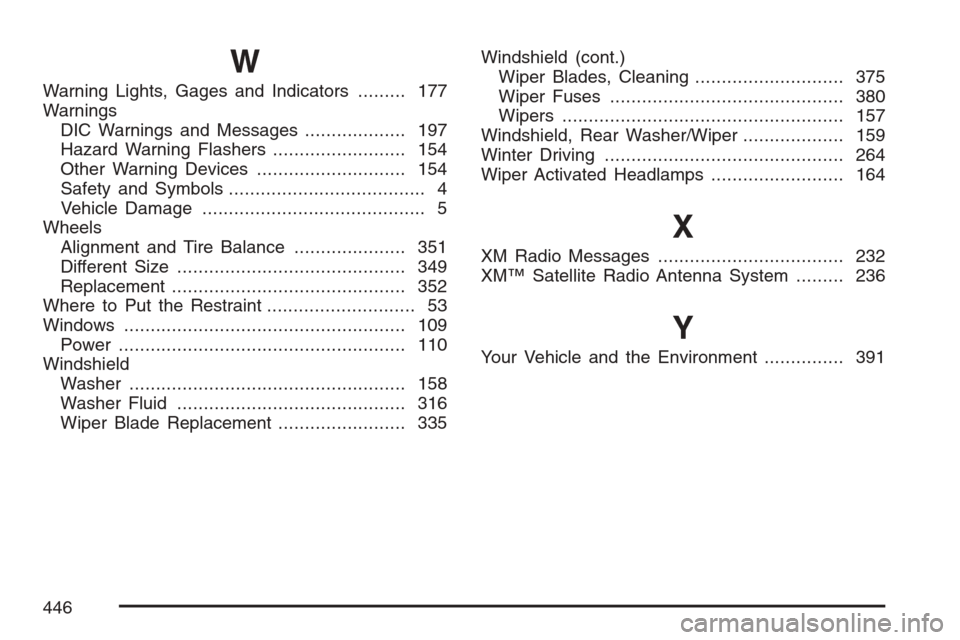
W
Warning Lights, Gages and Indicators......... 177
Warnings
DIC Warnings and Messages................... 197
Hazard Warning Flashers......................... 154
Other Warning Devices............................ 154
Safety and Symbols..................................... 4
Vehicle Damage.......................................... 5
Wheels
Alignment and Tire Balance..................... 351
Different Size........................................... 349
Replacement............................................ 352
Where to Put the Restraint............................ 53
Windows..................................................... 109
Power...................................................... 110
Windshield
Washer.................................................... 158
Washer Fluid........................................... 316
Wiper Blade Replacement........................ 335Windshield (cont.)
Wiper Blades, Cleaning............................ 375
Wiper Fuses............................................ 380
Wipers..................................................... 157
Windshield, Rear Washer/Wiper................... 159
Winter Driving............................................. 264
Wiper Activated Headlamps ......................... 164
X
XM Radio Messages................................... 232
XM™ Satellite Radio Antenna System......... 236
Y
Your Vehicle and the Environment............... 391
446